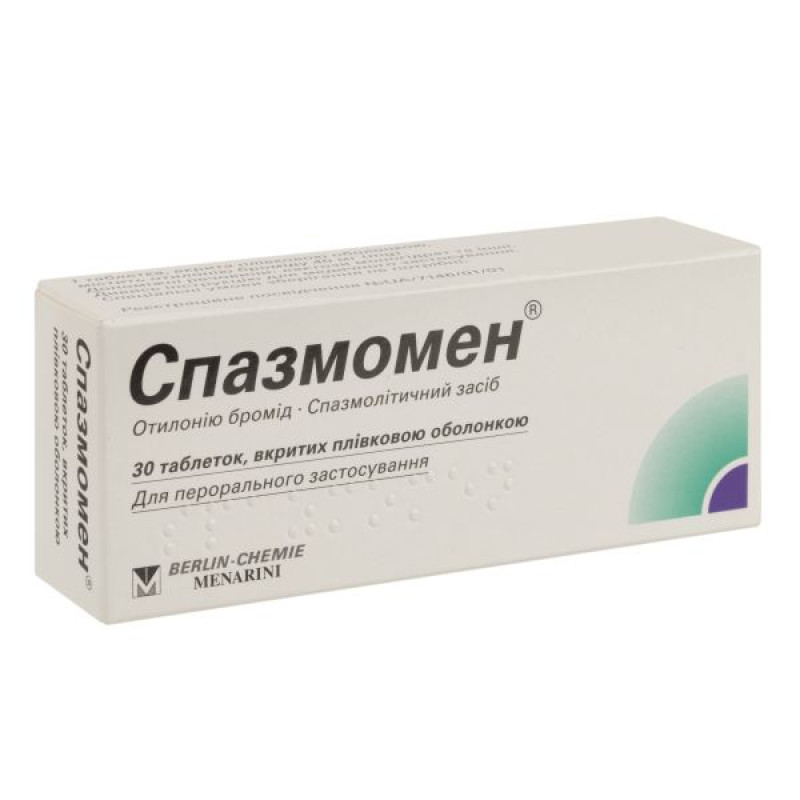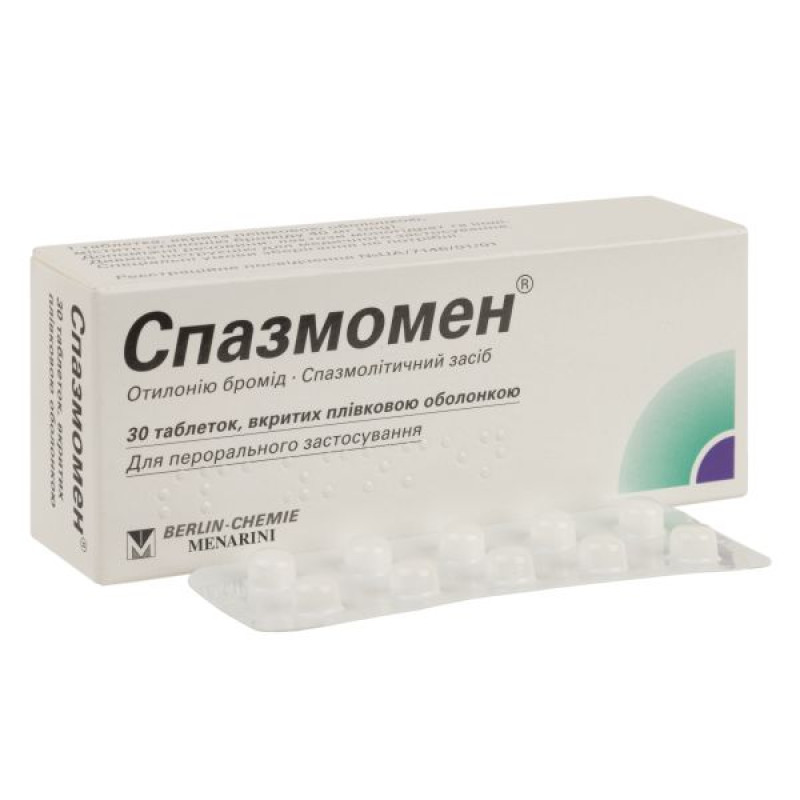Spazmomen film-coated tablets 40 mg No. 30

Instructions Spazmomen film-coated tablets 40 mg No. 30
Composition
active ingredient: otilonium bromide;
1 film-coated tablet contains otilonium bromide 40 mg;
excipients: lactose monohydrate, rice starch, sodium starch glycolate (type A), magnesium stearate, hypromellose, titanium dioxide (E 171), polyethylene glycol 4000, polyethylene glycol 6000, talc.
Dosage form
Film-coated tablets.
Main physicochemical properties: biconvex tablets from white to almost white color, coated with a film shell, having a round shape.
Pharmacotherapeutic group
Drugs used in functional disorders of the digestive tract. Synthetic anticholinergics, quaternary ammonium compounds. ATX code A03A B06.
Pharmacological properties
Pharmacodynamics
Otilonium bromide is a typical representative of the class of drugs based on the quaternary salt of 2-aminoethyl-N-benzylaminobenzoate.
Otilonium bromide has an antispasmodic effect on the smooth muscles of the distal intestine (colon and rectum). This effect is observed at doses that do not affect gastric secretion and do not exhibit typical atropine-like side effects.
Mechanism of action
Otilonium bromide acts primarily by altering the flow of Ca2+ ions between the cellular and extracellular space, reducing the trigger factor of contractile activity. Otilonium bromide inhibits the opening of L-type calcium channels and the penetration of Ca2+ ions into the smooth muscle of the intestine. An additional pharmacodynamic effect is achieved by inhibiting tachykinin and muscarinic receptors.
Clinical efficacy and safety
An extended analysis of a double-blind, placebo-controlled, 15-week study of otilonium bromide (SpC1M study) in 378 patients with irritable bowel syndrome (IBS) showed that the response rate at 2–4 months was significantly higher in the otilonium bromide group (36.9%) than in the placebo group (22.5%; p=0.007). The monthly response rate was higher in the otilonium bromide group compared to placebo (P<0.05). The overall monthly and weekly proportion of the population with a therapeutic response for individual endpoints (intensity and frequency of pain and discomfort, flatulence/bloating, severity of diarrhoea and constipation, mucus in stools) was significantly higher in the otilonium bromide group compared to the placebo group, with a range of differences of 10 to 20%. Analysis of the results for stool frequency and stool consistency suggests that patients with diarrhoea have an additional benefit. The safety profile of otilonium bromide was similar in nature to placebo.
A double-blind, placebo-controlled clinical trial (n=365 patients with IBS) (OBIS study) confirmed the efficacy of otilonium bromide compared to placebo in reducing the frequency of abdominal pain, the degree of bloating, and preventing symptom recurrence.
Pharmacokinetics
It is assumed that otilonium bromide penetrates the site of pharmacological action through the intestinal wall, since the systemic absorption of the drug after oral administration is very low (3%). Therefore, its plasma concentration is low. After oral administration, a high rate of distribution of the drug into the smooth muscles of the colon and rectum has been described. Administration of the drug shortly before meals ensures pharmacologically effective local bioavailability of the drug at the site of therapeutic action and during the expectation of the most pronounced symptoms of the disease. The use of otilonium bromide in patients with impaired renal and hepatic function has not been studied. Since otilonium bromide penetrates the systemic circulation in very small quantities, a decrease in renal and hepatic function is not expected.
Preclinical safety data
Acute toxicity: No lethal effects were reported when administered orally to dogs at doses up to 1000 mg/kg, and when administered orally to rats, the LD50 was 1500 mg/kg.
Chronic toxicity: No hematological or histological abnormalities were observed in animals when otilonium bromide was administered at a dose of 80 mg/kg for 180 days.
Embryotoxicity: No embryotoxic or teratogenic effects were observed in rats and rabbits at doses up to 60 mg/kg.
Genotoxicity: Standard clinical tests in vitro and in vivo did not reveal any mutagenic potential of otilonium bromide.
Indication
Symptomatic treatment of irritable bowel syndrome (IBS) and spasms of the distal intestine (colon and rectum) accompanied by pain, relief of abdominal pain, bloating and impaired peristalsis caused by spasm of the smooth muscles of the distal intestine, in patients aged 18 years and older.
Treatment of IBS should begin with non-pharmacological measures (lifestyle changes, diet, emotional support, psychotherapy), pharmacotherapy is prescribed when such measures do not have the desired effect.
Contraindication
History of hypersensitivity reactions to the active substance or to any of the excipients of the drug.
Interaction with other medicinal products and other types of interactions
No drug interaction studies have been conducted with otilonium bromide. It is assumed that otilonium bromide, at the recommended daily dose of 1 tablet 2 or 3 times a day, administered throughout the entire gastrointestinal tract, will not affect the absorption of other oral medications taken concurrently.
Application features
The drug should be used with caution in glaucoma, prostatic hypertrophy, and pyloric stenosis.
The drug contains lactose, therefore it is contraindicated in patients with lactase deficiency, congenital galactosemia or glucose/galactose malabsorption syndrome.
Ability to influence reaction speed when driving vehicles or other mechanisms
Spazmomen® has no or very little effect on the reaction speed when driving or using other mechanisms.
Use during pregnancy or breastfeeding
There are no clinical data on the use of the drug Spazmomen® during pregnancy or breastfeeding. In animal studies, Spazmomen® did not have an embryotoxic, teratogenic or mutagenic effect, and did not show reproductive and ontogenetic toxicity. However, like all drugs, it should be used during pregnancy or breastfeeding only if absolutely necessary and under the close supervision of a physician.
Method of administration and doses
Method of application.
The tablets should be swallowed whole with a glass of water. It is advisable to take the tablets 20 minutes before a meal.
Doses.
The recommended single dose is 1 tablet of 40 mg; the recommended daily dose is 80–120 mg (1 tablet 2–3 times a day). The dose depends on the clinical picture and response to therapy, and should be prescribed in accordance with the therapeutic guidelines for the treatment of IBS.
Duration of treatment: depends on the course of the disease. Physicians should periodically assess the need for continued therapy.
Special patient groups
Patients with impaired liver and kidney function.
No dose adjustment is required (for detailed information, see the Pharmacokinetics section).
Elderly patients.
No change in the dose of the drug is required.
Children
Clinical data on the use of the drug in patients under 18 years of age are limited, therefore it is not intended for use in children.
Overdose
In animal studies, otilonium bromide was practically non-toxic at doses many times the usual pharmacological dose (for detailed information, see section “Preclinical safety data”). Therefore, it is assumed that no serious adverse effects should occur in humans after an overdose. In case of overdose, symptomatic supportive therapy is recommended.
Adverse reactions
In clinical trials, Spazmomen® was well tolerated; a small number of adverse reactions were reported, which were similar in nature to those seen with placebo/reference drug (see table).
The frequency of adverse reactions in patients who used otilonium bromide can be classified as follows: common (≥1/100 to <1/10), uncommon (≥1/1000 to <1/100), rare (≥1/10000 to <1/1000).
Adverse reactions reported during clinical trials.
| Gastrointestinal tract | Uncommon: dry mouth, nausea, upper abdominal pain |
| Skin and subcutaneous tissue disorders | Uncommon: pruritus, erythema |
| General disorders and administration site conditions | Uncommon: weakness, asthenia |
| From the nervous system | Uncommon: headache |
| From the side of the organs of hearing and labyrinth | Uncommon: dizziness |
Isolated cases of cutaneous hypersensitivity reactions (urticaria, angioedema) have been reported during post-marketing surveillance. These cases were reported voluntarily from a population of uncertain size, making it impossible to reliably estimate their frequency and are therefore unknown.
Reporting of suspected adverse reactions.
Reporting suspected adverse reactions after a medicinal product has been authorised plays an important role. This allows for continued monitoring of the benefit/risk balance of the medicinal product.
Healthcare professionals should report any suspected adverse reactions through the national reporting system.
Expiration date
3 years.
Do not use the drug after the expiration date indicated on the package.
Storage conditions
No special storage conditions are required.
Packaging
10 film-coated tablets in a blister; 3 blisters in a cardboard box.
Vacation category
According to the recipe.
Producer
BERLIN-CHEMI AG. A. Menarini Manufacturing Logistics and Services S.r.L. A. Menarini Manufacturing Logistics and Services S.r.L.
Location of the manufacturer and its business address
Glienicker Weg 125, 12489, Berlin, Germany. Via Campo di Pile, 67100 L'Aquila (AC), Italy.
There are no reviews for this product.
There are no reviews for this product, be the first to leave your review.
No questions about this product, be the first and ask your question.








